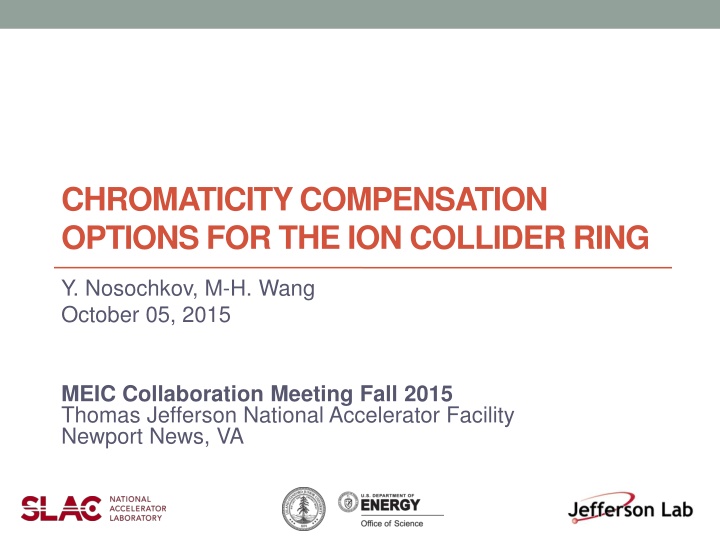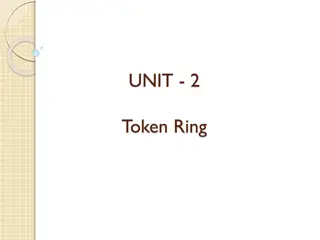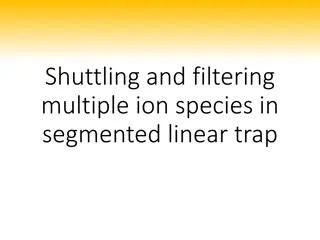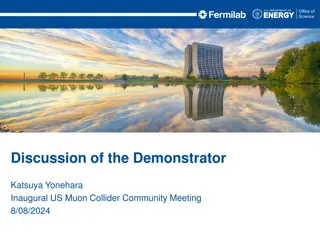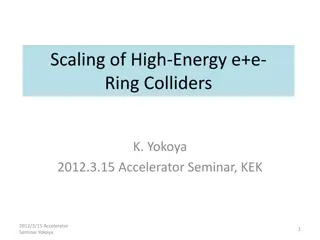Chromaticity Compensation Options for the Ion Collider Ring
The MEIC Interaction Region faces challenges due to high beta functions causing chromatic perturbation. To address this, local compensation through Chromaticity Compensation Block (CCB) with sextupoles is proposed. Three CCB options are presented for consideration. The report explores the impact of chromaticity on linear and non-linear tune shifts, emphasizing the need for corrective measures to maintain beam quality and dynamic aperture in the Final Focus region.
Download Presentation

Please find below an Image/Link to download the presentation.
The content on the website is provided AS IS for your information and personal use only. It may not be sold, licensed, or shared on other websites without obtaining consent from the author.If you encounter any issues during the download, it is possible that the publisher has removed the file from their server.
You are allowed to download the files provided on this website for personal or commercial use, subject to the condition that they are used lawfully. All files are the property of their respective owners.
The content on the website is provided AS IS for your information and personal use only. It may not be sold, licensed, or shared on other websites without obtaining consent from the author.
E N D
Presentation Transcript
CHROMATICITY COMPENSATION OPTIONS FOR THE ION COLLIDER RING Y. Nosochkov, M-H. Wang October 05, 2015 MEIC Collaboration Meeting Fall 2015 Thomas Jefferson National Accelerator Facility Newport News, VA
2 October 05, 2015 MEIC Collaboration Meeting Introduction Due to the low- *, the MEIC Interaction Region is characterized by very high -functions in the final focus (FF) quadrupoles. The latter cause large chromatic perturbation of energy dependent betatron tune and beta functions. This creates a large non-linear tune chromaticity and chromatic beam size and may significantly reduce the energy dependent dynamic aperture. The solution is to provide a local compensation of the FF chromaticity using special sextupoles placed in the nearby dispersive region (Chromaticity Compensation Block). The CCB must also compensate the non-linear geometric (amplitude dependent) aberrations created by the sextupoles. One version of the CCB system has been already developed for the MEIC (V. Morozov, Ya. Derbenev, et. al). In this report we present three alternative CCB options based on a more traditional scheme using I sextupole pairs. Corrections using local non- interleaved and distributed interleaved I pairs will be compared.
3 October 05, 2015 MEIC Collaboration Meeting Lattice without CCB 2.15 km 8-figure ring with one IP (baseline) IR Arc (90 cells) Arc (90 ) Straight (90 ) IP
4 October 05, 2015 MEIC Collaboration Meeting Final Focus and IR IP Asymmetric optics with L* = 3.6 m / 7.0 m. x* = 10 cm, y* = 2 cm, max = 2340 m (60 times higher than in arcs). No dispersion for CCB sextupoles must be placed outside of the IR.
5 October 05, 2015 MEIC Collaboration Meeting FF and linear chromaticity Due to the very high , the FF quads generate very large linear chromaticity KL/(4 ) (up to 65 units from one FF quad versus ~0.5 units from an arc quad). 6 FF quads Due to the optics asymmetry, the downstream FFB creates ~2.5 times more chromaticity than the upstream FFB. In total, the FF quads create 40-50% of the ring linear chromaticity.
6 October 05, 2015 MEIC Collaboration Meeting FF and non-linear chromaticity One of the main sources of non-linear chromaticity is perturbation of functions with = p/p, proportional to KL . = 0 Due to high and phase advance between the two FFBs, they amplify each other and generate very large ( ). See example on the right showing propagation of ( ) through FF. If not corrected, the chromatic would lead to large non- linear chromatic tune shift and chromatic beam smear at IP. = 0.15% ( ) before FF ( ) after FF Remedy: compensate the FFB linear and non-linear chromaticity with special local sextupoles (CCB).
7 October 05, 2015 MEIC Collaboration Meeting Local compensation of FF ( ( ) ) CCB FFB FFB CCB ( ) IP n ? ? ~ ?????2?? ? ? ~ ???1?? Use CCB to create a wave of ( ) opposite to the one from FFB for local cancellation. n phase advance from CCB sextupoles to FFB (in the correction plane). Large s s at CCB sextupoles for a reasonable sextupole strength. Large ratio x/ y (or y/ x) at X (Y) CCB sextupoles for more orthogonal X-Y correction (to reduce contributions to not in phase with FF). Minimize other chromatic perturbations between CCB and FFB (from other quads) place CCB and FFB close to each other if possible. Compensate geometric (amplitude dependent) non-linear effects from the CCB sextupoles (for example, using -I pairs).
8 October 05, 2015 MEIC Collaboration Meeting Original CCB design CCB FF y = n x = m IP SY SX SX Conceptual design by V. Morozov, Ya. Derbenev, et al. Compact optics, large and at sextupoles weak sextupoles, good chromatic correction. However, recent studies (V. M.) showed that uncompensated non-linear geometric effects (d x/dJy), caused by interleaved SX, SY sextupoles, limit dynamic aperture.
9 October 05, 2015 MEIC Collaboration Meeting Alternative CCB schemes based on I sextupole pairs Advantage: sextupole non-linear geometric effects in a I pair are self- compensated (if no other sextupoles within the pair). Disadvantage: the CCB section becomes longer compared to original CCB. Three sextupole schemes have been studied: 1. Two non-interleaved I pairs (X and Y) per each side of IP. 2. Several interleaved I pairs distributed in 90 arc cells nearest to IP with nominal arc functions. 3. Distributed interleaved I pairs in arc cells where functions at CCB sextupoles are locally increased. The -I sextupoles can be implemented using pairs of 90 arc cells. Two family sextupoles in the other arc cells compensate linear chromaticity. CCB CCB Scheme 1: two non-interleaved I pairs (cancellation of geometric effects) Schemes 2,3: Distributed interleaved I pairs (some residual geometric effects)
10 October 05, 2015 MEIC Collaboration Meeting Scheme-1: non-interleaved I sextupole pairs 2 upstream and 2 downstream non-interleaved I pairs, where at sextupoles is increased to 400-800 m, and x(y)/ y(x) ratios are a factor of 25-40 higher relative to the nominal arc. Advantages: high allows fewer CCB sextupoles, high ratio makes a more efficient correction, non-interleaved I pairs provide self-compensation of sextupole non-linear geometric aberrations. Qx,y = 24.22 / 23.16 The remaining linear chromaticity is canceled using 48 two-family sextupoles in the other arc cells. Y-pair Y-pair X-pair X-pair As a future study, the CCB - functions on the left/right sides could be made different to reflect the IR asymmetry.
11 October 05, 2015 MEIC Collaboration Meeting Scheme-2: distributed interleaved I pairs with nominal arc functions In this scheme, the CCB uses the nominal periodic arc cell optics, where is <40 m. 8 upstream and 10 downstream pairs are used. The remaining linear chromaticity is canceled using 32 two-family sextupoles in the other arc cells. Using multiple of 4 sextupoles in 90 cells provides self-compensation of ( ) and the sextupole geometric effects. Disadvantages: low requires more I pairs for a reasonable sextupole strength, low ratio of x(y)/ y(x) ~ 5 would result in less efficient correction due to more chromaticity generated not in FF phase, interleaved I pairs may result in residual non-linear geometric aberrations. Qx,y = 24.625 / 24.32 4+4 pairs 5+5 pairs
12 October 05, 2015 MEIC Collaboration Meeting Scheme-3: distributed interleaved I pairs with increased functions functions at the CCB sextupoles are locally increased to 100-200 m, thus increasing ratios a factor of 3-5 relative to nominal arc. 6 upstream and 6 downstream pairs are used. Advantages: higher allows fewer CCB sextupoles, thus leaving more cells for linear chromaticity sextupoles which will become weaker, higher ratio would make a more efficient correction. Disadvantages: interleaved I pairs may result in residual non-linear geometric aberrations. Qx,y = 24.22 / 24.16 The remaining linear chromaticity is canceled using 48 two-family sextupoles in the other arc cells. 3+3 pairs 3+3 pairs
13 October 05, 2015 MEIC Collaboration Meeting Compensation of ( ) (W-function) Scheme-1 2-pair correction Scheme-3 6-pair correction IP IP IP IP 2 non-interleaved I pairs per half-IR 3(x) + 3(y) distributed interleaved I pairs per half-IR with increased MAD W-function is a chromatic invariant related to amplitude of /( ). W-function is cancelled at the IP in order to minimize chromatic beam smear due to variation of * with W-function outside of IR is not perfectly cancelled due to contributions from other IR quads. It can be improved by fine tuning of phase advance between CCB and FFB, however it should be optimized along with chromatic tune shift and dynamic aperture.
14 October 05, 2015 MEIC Collaboration Meeting Non-linear chromatic tune shift (for = 10 p) Scheme-1 Scheme-2 Qx,y = 24.22 / 23.16 Qx,y = 24.625 / 24.32 Schemes 1 and 3 provide a similar level of correction comparable to the original CCB. The tune is nearly flat within 6 . In scheme-2 the tune non-linearities are larger. This is due to lower ratio at the sextupoles and longer CCB creating more contributions to chromaticity not in phase with the FF. Changing tune did not improve performance of this scheme. In all schemes, linear chromaticity is corrected to +1. Scheme-3 Qx,y = 24.22 / 24.16
15 October 05, 2015 MEIC Collaboration Meeting Variation of chromatic * (for = 10 p) Scheme-1 Scheme-2 Qx,y = 24.22 / 23.16 Qx,y = 24.625 / 24.32 Schemes 1 and 3 provide a very good correction comparable to the original CCB. The * is nearly flat within 6 . Scheme-3 In scheme-2 the non-linearities are much larger, as explained earlier. Qx,y = 24.22 / 24.16
16 October 05, 2015 MEIC Collaboration Meeting Sextupole K-values and parameters Sextupoles Scheme-1: local non- interleaved I pairs 0.8172 Distributed interleaved I pairs Scheme-2: nominal arc Scheme-3: increased SXT01,1R (linear) 1.5143 0.7305 SXT02,2R (linear) 1.1938 2.9742 1.1698 SXTIPX (CCB) 0.2448 0.4756 0.3573 SXTIPY (CCB) 0.4849 1.4237 0.6929 SXTIPXR (CCB) 0.6868 1.4232 0.9669 SXTIPYR (CCB) 0.8140 2.7850 1.1880 Qty of SXT01,02(R) 48 32 48 Qty of SXTIPX,Y(R) 8 36 24 CCB quad K1max Tune, X/Y 0.2074 0.1587 0.1999 24.22 / 23.16 24.625 / 24.320 24.22 / 24.16 Natural , X/Y -111.5 / -131.7 -101.5 / -112.2 -105.4 / -130.6
17 October 05, 2015 MEIC Collaboration Meeting Conclusions Three options of CCB optics, based on I sextupole pairs, were studied with non-interleaved and distributed interleaved I pairs (with and without enhancement). The best compensation of non-linear chromaticity (tune and *) (which is comparable to correction in the original CCB) was achieved using schemes 1 (non-interleaved I pairs) and 3 (distributed interleaved pairs) where -functions and -ratio at the sextupoles were made large. The scheme-1 appears as the best option (out of three) as it provides a better self-compensation of the sextupole non-linear amplitude dependent effects. It also uses fewer sextupoles. Potential improvements to these schemes could include fine tuning of the phase advance between the CCB and the FFB, and optimization of CCB -functions taking into account the IR optics asymmetry. The next step is to study dynamic aperture for these schemes (see next talk by M-H. Wang).
